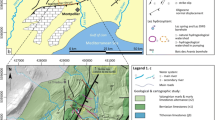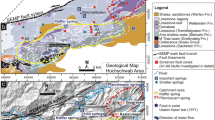Abstract
Rock and fluid geochemical data from Lahendong, Indonesia, were analyzed to evaluate the influence of fault zones on reservoir properties. It was found that these properties depend on fault-permeability controlled fluid flow.
Results from measurements of spring and well water as well as rocks and their hydraulic properties were combined with hydrochemical numerical modeling. The models show that the geothermal field consists of two geochemically distinct reservoir sections. One section is characterized by acidic water, considerable gas discharge and high geothermal-power productivity—all related to increased fault zone permeability. The other section is characterized by neutral water and lower productivity.
Increased fluid flow in the highly fractured and permeable areas enhances chemical reaction rates. This results in strong alteration of their surrounding rocks. Numerical models of reactions between water and rock at Lahendong indicate the main alteration products are clay minerals. A geochemical conceptual model illustrates the relation between geochemistry and permeability and their distribution within the area.
Our conceptual model illustrates the relation between geochemistry and fault-zone permeability within the Lahendong area. Further mapping of fault-related permeability would support sustainable energy exploitation by avoiding low-productive wells or the production of highly corroding waters, both there and elsewhere in the world.
Zusammenfassung
Die Analyse von geochemischen Daten am Standort Lahendong in Indonesien wird in dieser Studie für die Untersuchung des Einflusses von Störungszonen auf Reservoireigenschaften genutzt. Diese Eigenschaften sind von Grundwasserbewegungen in Störungszonen und deren Permeabilitäten abhängig.
In unserem Ansatz werden die Ergebnisse von physikochemikalischen Messungen an Brunnen und Quellen, Laboruntersuchungen zur Zusammensetzung von Wasser und Gesteinen und deren hydraulische Eigenschaften mit den Resultaten aus hydrochemischen Simulationen kombiniert. Die Ergebnisse zeigen, dass das geothermische Feld aus zwei geochemisch unterschiedlichen Reservoirbereichen besteht, wovon eins durch saures Wasser, erhöhte Gasaustritte und höhere Produktionsraten charakterisiert ist und das andere durch neutrale Wässer charakterisiert ist. Durch intensive Grundwasserbewegungen und chemische Reaktionen in Störungszonen, weisen Gesteine vor allem in diesen Bereichen starke Alterationserscheinungen auf. Die chemischen Reaktionen zwischen Wasser und Gestein wurden durch numerische Simulationen abgebildet und zeigen, dass durch die Alterationsprozesse vor allem Tonminerale gebildet werden. Ein konzeptionelles Modell stellt den Zusammenhang zwischen geochemischen Eigenschaften und der Permeabilitätsverteilung im Gebiet dar.
Unser konzeptionelles Modell erklärt den Zusammenhang zwischen Geochemie und Permeabilitäten in Störungszonen in Lahendong. Die Untersuchung von Permeabilitätsverteilungen in geothermischen Reservoiren ist wichtig für eine nachhaltige Nutzung und verhindert das Bohren an unproduktiven Standorten, sowie die Förderung von sauren, aggressiven Wässern in Lahendong und vergleichbaren Standorten.






Similar content being viewed by others
References
Appelo, C.A.J.: Principles , caveats and improvements in databases for calculating hydrogeochemical reactions in saline waters from 0 to 200 ° C and 1 to 1000 atm. Appl. Geochemistry 55, 62–71 (2015)
Arnorsson, S.: The use of mixing models and chemical geothermometers for estimating underground temperatures in geothermal systems. J. Volcanol. Geotherm. Res. 23, 299–335 (1985)
Arnorsson, S.: Arnorsson-Isotopic and chemical techniques in geothermal exploration, development and use. Report, International Atomic Energy Agency, Vienna (2000)
Arnorsson, S., Stefansson, A., Bjarnason, J.O.: Fluid-Fluid Interactions in Geothermal Systems. Rev. Mineral. Geochem. 65, 259–312 (2007). doi:10.2138/rmg.2007.65.9
Belsky, A., Hellenbrandt, M., Karen, V.L., Luksch, P.: New developments in the Inorganic Crystal Structure Database (ICSD): accessibility in support of materials research and design. Acta Crystallogr. B. 58, 364–369 (2002) doi:10.1107/S0108768102006948
Bergerhof, G., Brown, I.D.: Inorganic crystal structure database. Chrystallographic Database, International Union of Chrystallography (1987)
Brehme, M., Scheytt, T., Çelik, M., Dokuz, U.E.: Hydrochemical characterisation of ground and surface water at Dörtyol/Hatay/Turkey. Environ. Earth Sci. 63, 1395–1408 (2010). doi:10.1007/s12665-010-0810-1
Brehme, M., Haase, C., Regenspurg, S., Moeck, I., Deon, F., Wiegand, B.A., Kamah, Y., Zimmermann, G., Sauter, M.: Hydrochemical patterns in a structurally controlled geothermal system. Mineral. Mag. 77, 767 (2013) doi:10.1180/minmag.2013.077.5.2
Brehme, M., Moeck, I., Kamah, Y., Zimmermann, G., Sauter, M.: A hydrotectonic model of a geothermal reservoir—A study in Lahendong, Indonesia. Geothermics 51, 228–239 (2014). doi:10.1016/j.geothermics.2014.01.010
Browne, P.R.L.: Hydrothermal alteration as an aid in investigating geothermal fields. Geothermics. 2, 564–570 (1970) doi:10.1016/0375-6505(70)90057-X
Corsi, R.: Scaling and corrosion in geothermal equipment: problems and preventive measures. Geothermics. 15, 839–856 (1986)
Deon, F., Regenspurg, S., Zimmermann, G.: Geothermics Geochemical interactions of Al2O3 -based proppants with highly saline geothermal brines at simulated in situ temperature conditions. Geothermics. 47, 53–60 (2013)
Deon, F., Förster, H.-J., Brehme, M., Wiegand, B., Scheytt, T., Moeck, I., Jaya, M.S., Putriatni, D.J.: Geochemical/hydrochemical evaluation of the geothermal potential of the Lamongan volcanic field (Eastern Java, Indonesia). Geotherm. Energy. 3, 20 (2015)
Ellis, A.J., Mahon, W.A.J.: Chemistry and geothermal systems. Academic Press Inc, New York (1977)
Giencke, J.: Introduction to EVA. Bruker Cooperation, Billerica (2007)
Giggenbach, W.F.: Geothermal solute equilibria. Derivation of Na-K-Mg-Ca geoindicators. Geochim. Cosmochim. Acta. 52, 2749–2765 (1988). doi:10.1016/0016-7037(88)90143-3
Hernandez Castaneda, M.C.: Characterization of silica precipitates formed at geothermal conditions. Universität Freiburg, Freiburg im Breisgau (2014)
John, L.: Hydrothermal alteration mineralogy in geothermal fields with case examples from Olkaria Domes geothermal field, Kenya. Report, UNU-GTP (2007)
Koestono, H.: Lahendong Geothermal Field, Indonesia: Geothermal model based on wells LHD-23 and LHD-28. Master-Thesis at University of Iceland (2010)
Kwiatek, G., Bulut, F., Bohnhoff, M., Dresen, G., Oates, S., Santos, P. A.: High-resolution analysis of seismicity induced at Berlín geothermal field, El Salvador, (2013). Geothermics, doi: 10.1016/j.geothermics.2013.09.008
Larson, A.C., Von Dreele, R.B.: GSAS—General Structure Analysis System. Los Alamos National Laboratory Report LAUR 86–748, University of California (2004)
Layman, E., Soemarinda, S.: The Patuha Vapor-Dominated Resource West Java, Indonesia. Proceedings of the 28th Workshop on Geothermal Reservoir Engineering, pp. 56–65. Stanford University, Stanford (2003)
Milsch, H., Priegnitz, M., Blöcher, G.: Permeability of gypsum samples dehydrated in air. Geophys. Res. Lett. 38, 6 (2011). doi:10.1029/2011GL048797
Moeck, I., Dussel, M.: Fracture networks in Jurassic carbonate rock of the Algarve Basin (South Portugal): Implications for aquifer behaviour related to the recent stress field. IHA Sel. Pap. Ser. 9, 479–488 (2007)
Nicholson, K.: Geothermal fluids—chemistry and exploration techniques. Springer, Berlin (1993)
Powell, T., Cumming, W.: Spreadsheets for geothermal water and gas geochemistry. Proceedings of the 35th Workshop on Geothermal Reservoir Engineering. Stanford University, Stanford (2010)
Parkurst, D., Thorstenson, D., Plummer, L.: PHREEQE, a computer program for geochemical calculations, US Geological Survey Water. Report, USGS (1980)
Parkhurst, D., Appelo, C.A.J.: Description of Input and Examples for PHREEQC Version 3a Computer Program for Speciation, Batch-reaction, One-dimensional Transport, and Inverse Geochemical Calculations. Model. Tech. B. 6 497 (2013)
Robinson, D., Peng, D., Chung, S.: The development of the Peng-Robinson equation and its application to phase equilibrium in a system containing methanol. Fluid Phase Equilib. 24, 25–41 (1985). doi:10.1016/0378-3812(85)87035-7
Reyes, A., Giggenbach, W., Saleras, J.: Petrology and Geochemistry of Alto Peak, a Vapor-cored Hydrothermal System, Leyte Province, Philippines. Geothermics 22, 479–519 (1993)
Schön, J.H.: Physical properties of rocks. Elsevier Ltd., Amsterdam (2004)
Siahaan, E.E., Soemarinda, S., Fauzi, A., Silitonga, T., Azimudin, T., Raharjo, I.B.: Tectonism and Volcanism Study in the Minahasa Compartment of the North Arm of Sulawesi Related to Lahendong Geothermal Field, Indonesia, in: Proceedings World Geothermal Congress 2005, Antalya, Turkey, 24–29 April 2005 (2005)
Sriwana, T., van Bergen, M.J., Varekamp, J.C., Sumarti, S., Takano, B., van Os, B.J.H., Leng, M.J.: Geochemistry of the acid Kawah Putih lake, Patuha Volcano, West Java, Indonesia. J. Volcanol. Geotherm. Res. 97, 77–104 (2000). doi:10.1016/S0377-0273(99)00178-X
Surachman, S., Tandirerung, S.A., Buntaran, T., Robert, D.: Assessment of the Lahendong geothermal field, North Sulawesi, Indonesia, in: Proceeding Indonesian Petroleum Association, Sixteenth Annual Convention, October 1987. pp. 385–398 (1987)
Tanikawa, W., Shimamoto, T.: Comparison of Klinkenberg-corrected gas permeability and water permeability in sedimentary rocks. Int. J. Rock Mech. Min. Sci. 46, 229–238 (2009). doi:10.1016/j.ijrmms.2008.03.004
Toby, B.: EXPGUI, a graphical user interface for GSAS. J. Appl. Crystallogr. 34, 210–213 (2001)
Truesdell, A.H., Stallard, M.L., Trujillo, P.E., Counce, D., Janik, C.J., Winnett, T.L., Goff, F., Shevenell, L.: Interpretation of fluid chemistry from the PLTG-1 exploratory drill hole, Platanares. Honduras. Geotherm. Resour. Counc. Transactions. 11, 217–222 (1987)
Utami, P.: Hydrothermal alteration and the evolution of the Lahendong geothermal system, North Sulawesi, Indonesia. Dissertation, University of Auckland, Auckland (2011)
Utami, P., Siahaan, E.E., Azimudin, T., Browne, P.R.L., Simmons, S.F.: Overview of the Lahendong geothermal field, North Sulawesi, Indonesia: A progress report, in: Proceedings of the 26th NZ Geothermal Workshop 2004. pp. 1–6 (2004)
White, D.E.: Thermal Water of Volcanic origin. Bull. Geol. Soc. Am. 68, 1637–1658 (1957)
Wiegand, B.A., Brehme, M., Teuku, F., Amran, I.A., Prasetio, R., Kamah, Y., Sauter, M.: Geochemical and isotopic investigation of fluids from Lahendong geothermal field. Mineral. Mag. 77, 2491 (2013). doi:10.1180/minmag.2013.077.5.23
Acknowledgments
The authors acknowledge the continuous support within the team of the International Centre for Geothermal Research. We thank S. Tonn and K. Günther for fluid-analyses, R. Naumann, A. Gottsche, H. Liep and M. Ospald for geochemical analyses and Dr. F. Bulut for remarks on the manuscript. We would like to thank Dr. H. Milsch, B. Peters and D. Otten for helping at the Gas-Permeameter. Prof. M. Hochstein is greatly acknowledged for continuous fruitful discussions, which made this study possible. M. Andhika supported this work with assisting in communication in Indonesia and continuos discussion on the topic. I am deeply grateful to Prof. P. Malin, who reviewed the manuscript and took care of linguistic issues. Giggenbach-diagrams have been done with the help of an excel-sheet provided by Powell and Cumming (2010).
Author information
Authors and Affiliations
Corresponding author
Rights and permissions
About this article
Cite this article
Brehme, M., Deon, F., Haase, C. et al. Fault controlled geochemical properties in Lahendong geothermal reservoir Indonesia. Grundwasser 21, 29–41 (2016). https://doi.org/10.1007/s00767-015-0313-9
Received:
Revised:
Published:
Issue Date:
DOI: https://doi.org/10.1007/s00767-015-0313-9




